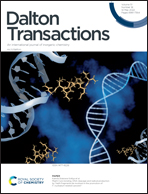Digging into protein metalation differences triggered by fluorine containing-dirhodium tetracarboxylate analogues†
Abstract
The catalytic and biological properties of dirhodium tetracarboxylates ([Rh2(μ-O2CR)4L2], L = axial ligand and R = CH3-, CH3CH2-, etc.) largely depend on the nature of bridging carboxylate equatorial μ-O2CR ligands, which can be easily exchanged by solvent molecules when R is CF3 (i.e. μ-O2CR is trifluoroacetate, tfa). Here, we prepared the [Rh2(OAc)(tfa)3] compound and investigated its interaction with bovine pancreatic ribonuclease and lysozyme under the same conditions used to study the reactivity of these proteins with [Rh2(OAc)4] and [cis-Rh2(OAc)2(tfa)2]. UV-vis absorption spectroscopy and 19F nuclear magnetic resonance studies indicate that [Rh2(OAc)(tfa)3] rapidly loses tfa ligands and interacts with the proteins. Crystallographic data demonstrate that the reaction of [Rh2(OAc)(tfa)3] with proteins can lead to products that are significantly different when compared to those obtained with [Rh2(OAc)4] and [cis-Rh2(OAc)2(tfa)2]: the dirhodium centre can bind the side chain of His residues at both axial and equatorial sites, at variance with what is found in the case of [Rh2(OAc)4] and [cis-Rh2(OAc)2(tfa)2]. These data indicate that the hydrolysis of dirhodium tetracarboxylates plays a significant role in defining their reaction with proteins allowing the formation of unexpected reaction products. These results suggest that [cis-Rh2(OAc)2(tfa)2] and [Rh2(OAc)(tfa)3] can be used to obtain different dirhodium/peptide and dirhodium/protein adducts with distinct catalytic properties and can explain the different cytotoxicity exhibited by tfa-containing dirhodium tetracarboxylates.



 Please wait while we load your content...
Please wait while we load your content...